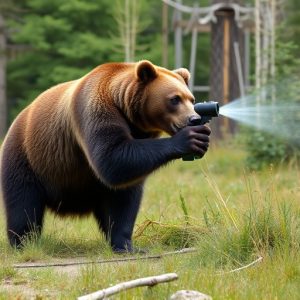GrizGuard Bear Spray Training: Safety, Science & Responsible Usage
Bear spray, an effective deterrent against aggressive bears, leaves residue with significant ecologi…….
Bear spray, an effective deterrent against aggressive bears, leaves residue with significant ecological impacts on wildlife, including plants, soil, and aquatic systems. Proper usage training through programs like GrizGuard equips individuals to minimize bear spray residue while maximizing its impact as a last resort. Responsible use includes understanding wildlife behavior, maintaining distance, targeted deployment, proper disposal, and avoiding unnecessary use to protect sensitive habitats. Case studies show that this training minimizes wildlife impact and enhances outdoor enthusiasts' safety during encounters with bears.
“In regions where bear encounters are common, proper safety measures are paramount. This is where GrizGuard bear spray safety training steps in as a vital tool for outdoor enthusiasts and professionals alike. Our comprehensive guide explores the effectiveness of bear spray, with a focus on its composition and how it interacts with the environment, particularly regarding bear spray residue and wildlife impact.
We delve into the detailed training program offered by GrizGuard, providing insights into responsible usage and best practices to ensure safety and conservation in potentially dangerous situations.”
- Understanding Bear Spray: Its Composition and Effectiveness
- GrizGuard Bear Spray Training: A Comprehensive Program
- The Science Behind Bear Spray Residue: Impact on Wildlife
- Responsible Usage: Best Practices for Safety and Conservation
- Real-World Scenarios: Case Studies of Bear Spray Safety Training in Action
Understanding Bear Spray: Its Composition and Effectiveness
Bear spray, also known as urushiol-based spray, is a powerful deterrent designed to protect individuals from aggressive bears. Its composition includes capsaicin, a compound derived from chili peppers, mixed with other ingredients like water and propellants. When sprayed, it creates a residue that irritates the bear’s eyes, nose, and throat, temporarily disorienting them and allowing the user time to escape.
The effectiveness of bear spray lies in its ability to create a barrier between the user and the bear. The spray residue can remain active for extended periods, even under moist conditions, ensuring continued protection. However, it’s crucial to understand that bear spray doesn’t always result in a complete avoidance of wildlife impact. In some cases, bears may still charge despite the spray, especially if they have cubs or are protecting food sources. Therefore, proper training on usage and awareness of local wildlife behavior is essential when relying on bear spray for safety.
GrizGuard Bear Spray Training: A Comprehensive Program
GrizGuard offers a comprehensive bear spray safety training program designed to equip individuals with the knowledge and skills necessary to navigate encounters with wildlife effectively. This intensive course delves into the proper use of bear spray, focusing on techniques to minimize Bear Spray Residue while maximizing its impact against potential threats. Participants learn about the environmental and ecological impacts of bear spray residue on wildlife habitats, fostering a responsible approach to conservation.
Through interactive demonstrations and practical exercises, trainees gain hands-on experience with different types of bear spray gear and learn optimal application strategies. The program also covers important aspects like understanding bear behavior, identifying potential risks, and knowing when and how to deploy bear spray responsibly. By the end of the training, individuals are better prepared to protect themselves and contribute to minimizing the ecological footprint of their interactions with wildlife.
The Science Behind Bear Spray Residue: Impact on Wildlife
Bear spray residue, while effective in deterring bears during encounters, has a significant impact on wildlife beyond the immediate moment of confrontation. The chemicals contained within bear spray, primarily capsaicin and other irritants, can persist in the environment and have lasting effects on various species. Studies have shown that residual capsaicin can remain active for extended periods, sometimes up to weeks, in affected plants and soil. This persistence can lead to chronic irritation and even death for non-target wildlife, including birds, small mammals, and insects.
The impact of bear spray residue extends further still, as it can also disrupt the ecological balance. For example, the presence of residual chemicals may deter natural predators from hunting in areas frequently treated with bear spray, disrupting predator-prey dynamics. Additionally, it can accumulate in aquatic systems through run-off, posing risks to aquatic organisms and potentially entering the food chain. Understanding these impacts is crucial for responsible bear spray use and ensuring that humans’ safety measures do not inadvertently harm the broader wildlife community.
Responsible Usage: Best Practices for Safety and Conservation
Responsible usage of bear spray is paramount for both personal safety and conservation efforts. It’s crucial to understand that bear spray residue can have a significant wildlife impact, especially when used near sensitive habitats or in areas with high biodiversity. Best practices involve maintaining a safe distance from bears whenever possible, using spray only as a last resort, and avoiding unnecessary releases which can lead to increased contamination of the environment.
When deploying bear spray, it’s essential to target the bear’s face and eyes, as this is the most effective way to deter an attack. Users should be aware that bear spray has a limited range and must be deployed quickly and accurately. Proper disposal methods should also be followed to minimize environmental harm, ensuring that used cans are disposed of in designated areas or recycled appropriately.
Real-World Scenarios: Case Studies of Bear Spray Safety Training in Action
In real-world scenarios, GrizGuard bear spray safety training has proven invaluable in minimizing wildlife impact and enhancing outdoor enthusiasts’ security. Case studies across various regions highlight successful implementations where individuals equipped with this knowledge have effectively deterred bears and mitigated potential attacks. For instance, in areas known for frequent grizzly encounters, participants reported increased confidence after completing the program. They shared stories of close calls turned into safe escapes, attributing their success to understanding bear behavior and the strategic use of bear spray residue.
These training sessions go beyond theoretical knowledge by focusing on practical application. Trainees learn not only how to identify potential threats but also how to respond calmly under pressure. Through role-playing scenarios and hands-on demonstrations, they gain insights into the effectiveness of different spray techniques and the importance of using bear spray residue responsibly. This proactive approach ensures that adventurers can enjoy nature while minimizing risks associated with unexpected wildlife encounters.
GrizGuard bear spray safety training equips individuals with crucial knowledge and skills to navigate encounters with bears effectively. By understanding the composition and effectiveness of bear spray, the science behind residue’s wildlife impact, and best practices for responsible usage, users can ensure their safety and contribute to conservation efforts. Real-world case studies demonstrate the tangible benefits of this comprehensive program, emphasizing the importance of bear spray as a game-changer in bear country. Through proper training and responsible usage, we can minimize negative impacts on both humans and wildlife, fostering a harmonious coexistence.


